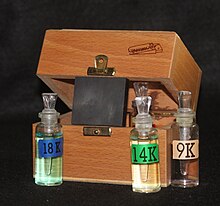Sample
The sample is an optical comparison method that is used to determine the approximate fineness of a precious metal alloy (coin, jewelry).
Basics
The sample was used to check coins as early as 600 BC. It is therefore one of the oldest test methods for precious metals and precious metal alloys. It is used by gold and silversmiths and others involved in the precious metals industry. With the random sample, all precious metal goods can be checked in a short time with only little material consumption, with simple aids and without significant damage to the goods. It does not matter whether it is raw material or jewelery. The sample can be used to detect differences in fineness of ten to twenty thousandths with great certainty; this method has been used for many years by Swiss precious metal testers to test finished precious metal products. The sample is used to estimate the value of jewelry, both when buying and selling antique jewelry and when estimating jewelry for insurance companies or for private individuals. It is also used to check old gold so that new alloys can be made from it, but also to distinguish jewelry made from so-called full goods from jewelry with precious metal coatings. The sample is also used to test non-ferrous metals such as copper or to test alloys such as bronze .
Required tools
Only a few tools are required for the sample. In addition to a test stone and corresponding test needles , various test liquids are used for the different materials. New gold acid and medallic acid are used as sample acids for gold. These are mixtures of nitric acid with distilled water and sometimes also with hydrochloric acid , with a certain mixing ratio this acid mixture is called aqua regia . A potassium dichromate solution or Savoie-Kienberger acid is used as the test acid for testing silver ; a mixture of acetic acid , nitric acid with dissolved silver and distilled water. A mixture of salmiak , verdigris , saltpeter and burnt copper is dissolved in distilled wine vinegar and used as a tincture as a test liquid for alloys such as tombac . A cold platinum testing acid based on potassium nitrate is used as the test acid for platinum, palladium and white gold, but this platinum testing acid reacts very slowly and quickly loses its effectiveness.
Testing process
For this purpose, a line is drawn on the surface of a test stone with the object to be tested and, parallel to this, a line with a test needle. Both lines must be equally thick and about 2.5 cm long. The prerequisite for this is that the test item and trial needle are made of the same alloy. The precious metal content can be determined from the color and the difference in brightness of the line . If no difference can be seen between the two lines, the precious metal content of the test piece corresponds to that of the test needle with a relatively high degree of accuracy. If there are differences, further lines are drawn with different trial needles. Since some gold-colored non-ferrous metals have the same color as the precious metal gold, the strokes are made with tasting acids such as B. dabbed separation water . Since gold is not attacked by septic fluid, only the non-precious metals are dissolved. In the case of test pieces that are suspected of only having a coating of precious metal, a small part of the surface is filed off with a fine file at an invisible place and only then is the line drawn on the test stone. The test procedures are similar for metals such as platinum, gold, silver, copper or alloys such as bronze or brass; they differ essentially only in the test acid used and the reaction of the metal to the test acid.
Accuracy of the sample
The accuracy of the sample achieved with the sample depends on several factors. First of all, the experience and the metallurgical and technical knowledge of the tester play a major role. Another component is the auxiliary tool used. The quality of the probing stones plays a role as well as the quantity and nature of the probing needles. But the concentration of the tasting acids used is also decisive for a good result. The composition and type of the alloys to be tested must also be taken into account. Ultimately, good workplace lighting also has an influence on the test result.
literature
- Karl Hradecky: The sample of precious metals. Springer Verlag Wien GmbH, Vienna 1930
Individual evidence
- ↑ a b c Federal Law Gazette for the Republic of Austria. Born 2001, 136th Ordinance: Hallmarking Ordinance ( Memento of May 12, 2013 in the Internet Archive ) (PDF; 26 kB) (restored by archive org. On February 23, 2015).
- ↑ a b c Walo Wälchli and Pierre Vuilleumier: Die Edelmetall-Strichprobe (last accessed on August 17, 2015).
- ↑ FM Feldhaus: The technology of prehistoric times, historical times and primitive peoples. Published by Wilhelm Engelmann, Leipzig and Berlin 1914.
- ↑ Johann Krauss: Economic house and art book . printed by Henrich Ebner, Allentown 1819.
- ↑ The well-experienced Scheid artist, or practical instruction on how to try and separate all ore and metals, especially gold and silver, with little expense and effort but with great benefit. Frankfurt and Leipzig 1755.
- ^ Johann Georg Krünitz: Economic Encyclopedia, or general system of state, town, house and agriculture, in alphabetical order. Nineteenth part, by Joachim Pauli, Berlin 1780.
